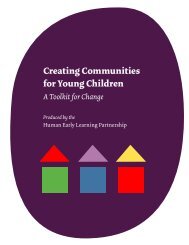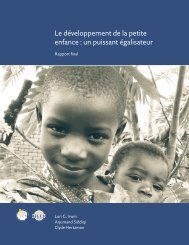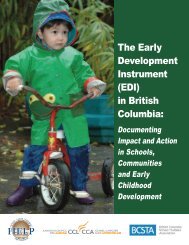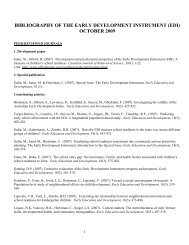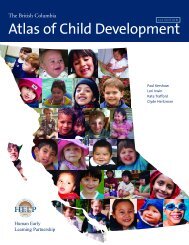Total Environment Assessment Model for Early Child Development
Total Environment Assessment Model for Early Child Development
Total Environment Assessment Model for Early Child Development
Create successful ePaper yourself
Turn your PDF publications into a flip-book with our unique Google optimized e-Paper software.
Spheres of<br />
Influence:<br />
The Individual<br />
of the environment on micro-physiological<br />
processes. (Many avenues of research have<br />
been pursued in this regard. In particular,<br />
many investigations have focused on measurement<br />
of blood pressure and cortisol levels<br />
in response to socioeconomic conditions) [21].<br />
Finally, the common understanding of the<br />
environments that are thought to be pertinent<br />
to children’s well-being still remains quite<br />
narrow. Future research must attend to the<br />
roles of environments (and their features)<br />
more broadly defined. There is a particular<br />
dearth of in<strong>for</strong>mation regarding regional,<br />
national, and global environments. The<br />
critical roles of factors operating at these larger<br />
geo-political levels is well illustrated by the<br />
analysis of the Convention of the Rights of the<br />
<strong>Child</strong> presented below.<br />
Two key integrated solutions are proposed<br />
here to resolve these issues. First, that explicit<br />
measures of biological embedding (rather than<br />
solely functional outcomes) become of equal<br />
priority in future research endeavors regarding<br />
child development. Second, that research<br />
attend to the broader environment as a context<br />
that influences early child development. The<br />
collective body of knowledge would benefit<br />
from comprehensive studies that incorporate<br />
both multiple geo-political contexts and<br />
collect in<strong>for</strong>mation on neurophysiological<br />
development (as well as functional outcomes<br />
of development) <strong>for</strong> children across these<br />
contexts.<br />
Though ideal, this of course would be a<br />
costly and logistically burdensome undertaking.<br />
A more intermediate approach might be to<br />
encourage smaller studies in different locales<br />
(e.g. different regions and nations) to attempt<br />
such ventures, so that a basis <strong>for</strong> comparison is<br />
established <strong>for</strong> outcomes related to biological<br />
embedding and functional aspects of development<br />
across various societies.<br />
crc & gc7 Challenges Remain<br />
There remain multiple challenges to the<br />
Convention and its General Comment. Most<br />
notably the question remains, to what extent<br />
do the Convention on the Rights of the <strong>Child</strong><br />
and the General Comment mirror the huge<br />
variety of “childhoods in a multicultural<br />
universe in need of exploration” [202].<br />
24<br />
In addition, the relationship between<br />
en<strong>for</strong>cement of the crc, possible resultant<br />
sanctions on countries in violation of the convention,<br />
and the possible ill-effects of these<br />
sanctions on ecd is perplexing. How to hold<br />
countries responsible <strong>for</strong> upholding children’s<br />
rights without in turn negatively affecting<br />
children’s development, remains an important<br />
question.<br />
Summary/Framing the<br />
Remainder of the Volume<br />
In keeping with the central importance of<br />
biological embedding and the influence of<br />
many and varied environmental factors<br />
<strong>for</strong> this process and <strong>for</strong> ecd more broadly,<br />
team-ecd provides a framework that uses<br />
a ‘cell-to-society’ approach to early child<br />
development. The basic premise is that the<br />
process of biological embedding and of early<br />
child development in the physical, language/<br />
cognitive, and socio-emotional domains<br />
is affected by variations in many aspects of<br />
environmental conditions and defined at<br />
many levels of societal aggregation.<br />
The child as an agent with a voice to<br />
contribute is an integral part of this approach.<br />
team-ecd draws on theoretical and empirical<br />
understandings in a broad array of disciplines<br />
to conceptualize the environments that are<br />
significant <strong>for</strong> children, the ways in which<br />
these interact with one another, and in turn<br />
how they influence early child development.<br />
key messages: the individual child<br />
1. Health, nutrition, and well-being of the<br />
mother are significant <strong>for</strong> the child’s<br />
development.<br />
2 . Three broad domains of development—physical,<br />
social–emotional and<br />
language–cognitive—are interconnected<br />
and equally important.<br />
3. <strong>Child</strong>ren shape their environments as well<br />
as being shaped by them.<br />
4 . Social determinants shape brain and<br />
biological development through their<br />
influence on the qualities of stimulation,<br />
support, and nurturance available to<br />
the child.<br />
5 . Play is critical <strong>for</strong> a child’s overall<br />
development.



